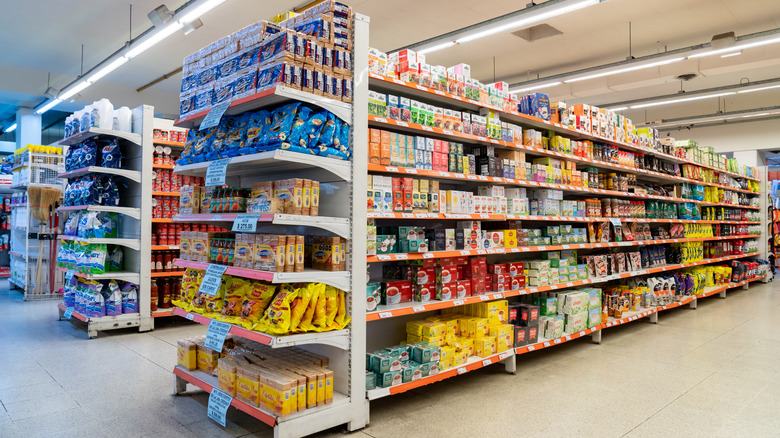How Grocery Store Endcaps Trick You Into Spending More
Who knew those display cases at the end of supermarket aisles had a catchy name all their own? Well, they do, and it's a fitting one. In retail industry parlance, those displays are known as endcaps. They perch at the end of long grocery-laden aisles, capping or crowning the long procession of edible goodies; that much is obvious. What's less obvious is why they exist and how they're maneuvered to improve the shopping experience.
Improving grocery shopping can be subjective, depending on who benefits. In an ideal customer-seller experience, endcaps would wrap their chunky arms around both, increasing profits for stores while increasing value for shoppers. Maybe a little of each takes place, but at its core, an endcap seemingly tilts toward a marketing scheme, one that tricks the average shopper into spending more money at checkout.
Endcaps are a simple yet genius way to reach that goal since they occupy prime retail space that shoppers must pass when curving into and out of aisles containing everyday grocery items. These cleverly stocked displays are often splashy, colorful, and stacked high with items you never knew you needed but suddenly can't resist. It's called impulse buying, and it's very lucrative for food manufacturers and grocery outlets. While that may sound manipulative at best, there's a broader viewpoint to consider, one that spotlights benefits on both sides of the proverbial retail aisle.
End-of-aisle displays go both ways
You're in a grocery store to actually buy groceries, so it's an understanding between buyers and sellers that money will exchange hands. Endcap displays are what pull you from the monotony of routine list-led shopping into small delights of indulgence. What's another five dollars to try out those snappy new crackers or a hot celebrity-endorsed energy drink?
There's merit in that way of thinking, especially when discovering new foods that become favorites. Instead of being stuffed amongst a flood of competitive products, the newbies get their moment in the limelight. And, grocers gain valuable insight into which new products appeal to customers, guiding decisions over what to stock. It can also introduce entire new categories to gauge interest, such as locally made sauces or organic grains, which sometimes require a little decoding to understand their labels.
End-of-aisle placement isn't just for new products; it can also provide convenient ways for consumers to find discounted sale items. This potentially benefits everyone in the food-shopping chain, from manufacturers pushing a product with lowered prices, to grocers providing customer value, and shoppers chopping a bit off their weekly food budgets. Does it all seem a bit manipulatively designed to trick you into spending more money? Yes, sometimes, and it's fair to compare prices with inner-aisle products to determine whether end-cap items are actually a good deal.
Before your next shopping trip, read up on our grocery store hacks for efficient shopping.

